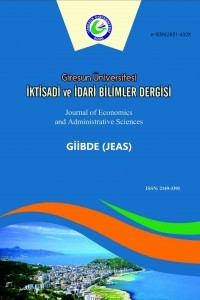GELİR YUMUŞATMA VE FİRMAYA-ÖZGÜ ETKENLER: TÜRKİYE ÖRNEĞİ
Bu çalışma, BIST'te işlem gören firmanın 2012-2019 dönemini kapsayan gelir yumuşatma davranışlarını incelemektedir. Çalışma, bu tür davranışları sektörel düzeyde irdelemektedir. Ayrıca firmaya-özgü etkenler -büyüklük, kaldıraç, büyüme- ve gelir yumuşatma uygulamaları arasındaki ilişkiler de incelenmiştir. Gelir yumuşatma faaliyetlerinin tespiti için Eckel Modeli (1981) kullanılmıştır. Analize göre 2012-2019 döneminde imalat sektöründe 3 gözlemden 1'inin, hizmet ve ulaştırma sektöründe 5 gözlemden 1'inin ve finans sektöründe 2 gözlemden 1'inin gelir yumuşatma uyguladığı kanaatine varılmıştır. Firmaya özgü faktörler dikkate alındığında, gelir yumuşatmayan firmalara kıyasla, imalat sektöründeki gelirlerini yumuşatan firmaların daha küçük, daha düşük kaldıraçlı olduğu ve daha düşük büyüme sergilediği görülmüştür. Bunun yanında, finans sektöründe gelirlerini yumuşatan grupta olan firmaların, yumuşatmayan firmalara göre daha küçük ve düşük kaldıraçlı olduğu ancak daha düşük büyümeye sahip olmadığı gözlemlenmiştir. Son olarak, hizmet ve ulaşım endüstrisi için firmaya özgü faktörler açısından gelirlerini yumuşatan ve yumuşatmayan firmalar arasında anlamlı bir fark tespit edilmemiştir.
Anahtar Kelimeler:
Gelir Yumuşatma, Kazanç Yumuşatma, Firmaya-Özgü Etkenler
INCOME SMOOTHING AND FIRM-SPECIFIC FACTORS: TURKEY CASE
This study investigates the income smoothing behaviours of the listed firms in BIST from the period spans from 2012 to 2019. The study scrutinizes such behaviours at the sectoral level. Moreover, the relationship between firm-specific factors -size, leverage, growth- and income smoothing practices are also examined. For the detection of the income smoothing so-called Eckel Model (1981) model is used. Based on the analysis it is found that 1 in 3 observation in the manufacturing sector, 1 in 5 observation in the utility and transportation sector and 1 in 2 observation in the finance sector implement income smoothing practices between the period of 2012-2019. Regarding firm-specific factors, it is found that compared with the non-smoothing firms, income- smoothing firms are smaller, low leveraged and exhibit lower growth in the manufacturing sector. Moreover, in the finance sector, income- smoothing firms are smaller and low leveraged comparing with the non- smoothing firms. Lastly, there is no significant difference between the income-smoothing and non-smoothing firms with regards to firm-specific factors for the utility & transportation industry.
Keywords:
Income Smoothing, Earnings Smoothing, Firm-Specific Factors,
___
- Akbari, F., Salehi, M. & Bagherpour Vlashani, M.A. (2019) The Relationship Between Tax Avoidance and Firm Value with Income Smoothing: A Comparison Between Classical and Bayesian Econometric in Multilevel Models, International Journal of Organizational Analysis, 27, 125-148.
- Bao, B. H. & Bao, D. H. (2004) Income Smoothing, Earnings Quality and Firm Valuation. Journal of Business Finance & Accounting, 31, 791-811.
- Beidleman, C. R. (1973) Income Smoothing: The Role of Management, Accounting Review, 48, 653-667.
- Bushman, M. R., & Piotroski, J. D. (2006) Financial Reporting Incentives for Conservative Accounting: The Influence of Legal and Political Institutions, Journal of Accounting and Economics, 42, 107- 148.
- Copeland, R. M. (1968) Income Smoothing. Journal of Accounting Research, 6, 101-116.
- Defond, M. L., & Park, C. W. (1997) Smoothing Income in Anticipation of Future Earnings. Journal of Accounting and Economics, 23, 115-139.
- Dichev, I. D., & Skinner, D. J. (2002) Large Sample Evidence on the Debt Covenant Hypothesis. Journal of Accounting Research, 40, 1091–1123.
- Eckel, N. (1981) The income smoothing hypothesis revisited. Abacus, 17, 28–40.
- Fudenberg, D., & Tirole, J. (1995) A Theory of Income and Dividend Smoothing Based on Incumbency Rents. Journal of Political Economy, 103, 75-93.
- Goel, A. M. & Thakor, A. V. (2003) Why Do Firms Smooth Earnings? The Journal of Business, 76, 151- 192.
- Healy, P. M. (1985). The Effect of Bonus Schemes on Accounting Decisions. Journal of Accounting and Economics, 7, 85-107.
- Ibrahim, A.E.A., Abdelfattah, T. & Hussainey, K. (2020) Artificial and Real Income Smoothing Around Corporate Governance Reforms: Further Evidence from Egypt", Journal of Applied Accounting Research, 21, 701-720.
- Lev, B., & S. Kunitzky. (1974) On the Association Between Smoothing Measures and the Risk of Common Stocks. The Accounting Review, 49, 259–270.
- Namazi, M. & Khansalar, E. (2011) An Investigation of The Income Smoothing Behavior of Growth and Value Firms (Case Study: Tehran Stock Exchange Market), International Business Research, 4, 84- 93.
- Li, S. & Richie, N. (2016) Income Smoothing and the Cost of Debt, China Journal of Accounting Research, 9, 175-190.
- Madhogarhia, P., Sutton, N.K., & Kohers, T. (2009) Earnings Management Practices Among Growth and Value firms, Applied Financial Economics, 19, 1767- 1778.
- Petersen, M. A., & S. R. Thiagarajan. (2000) Risk Measurement and Hedging: With and Without Derivatives. Financial Management, 29, 5–29.
- Richardson, S. A., Sloan, R. G., Soliman, M. T., & Tuna, I. (2002) Information in Accruals about Earnings Persistence and Future Stock Returns. Working Paper. University of Michigan.
- Ronen, J. and Sadan, S. (1981) Smoothing Income Numbers (Addison-Wesley).
- Sayuni, H. (2016) Determinant of Income Smoothing At Manufacturing Firms Listed On Indonesia Stock Exchange, International Journal of Business and Management Invention, 5, 01-04.
- Watts, R. L., & Zimmerman, J. L. (1990) Positive accounting theory: A Ten-Year Perspective. Accounting Review, 65, 131–156.
- White, G. I., Sondhi, A. C., & Fried, D. (2003) The Analysis and Use of Financial Statements 3rd Ed. John Wiley & Sons.
- ISSN: 2149-3391
- Yayın Aralığı: Yılda 2 Sayı
- Başlangıç: 2015
- Yayıncı: Giresun Üniversitesi
Sayıdaki Diğer Makaleler
1934 TARİHLİ 2510 SAYILI İSKÂN KANUNU VE BASINDAKİ YANSIMALARI
Bilge Kağan ŞAKACI, Selçuk ÖZKAYA
TÜRK MADENCİLİK SEKTÖRÜNDE YABANCI UZMAN İSTİHDAMI (1935-1980)
MİLLİ MÜCADELEYE HAZIRLIK DÖNEMİNDE TÜRK-RUS İLİŞKİLERİ
GELİR YUMUŞATMA VE FİRMAYA-ÖZGÜ ETKENLER: TÜRKİYE ÖRNEĞİ
AB ÜLKELERİNDE KAMUDAKİ KURUMSAL KALİTENİN EKONOMİK BÜYÜMEYE ETKİSİ: PANEL VERİ ANALİZİ
